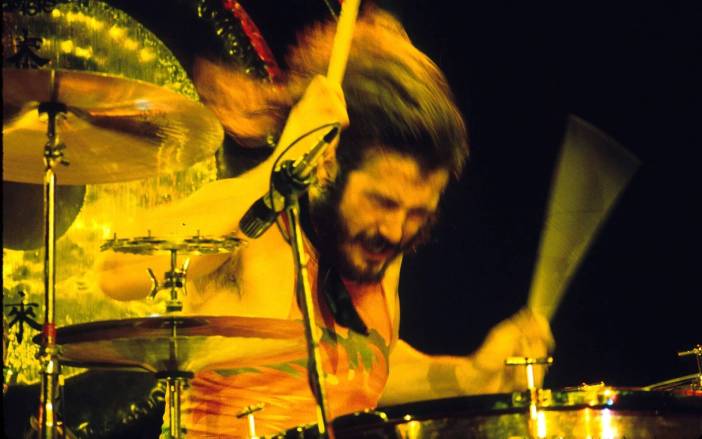
Okay, we covered John “Bonzo” Bonham’s remarkable Moby Dick drum solo a few years back. But not the legendary drummer’s career. Let’s right that wrong!
As Bonham was a monster of a drummer, with incredible natural feel and an innovative style. To this day still topping many Best Drummer Ever lists, his influence on music will not diminish any time soon.
On the Brilliance of John Bonham and His Thunderous Groove
Led Zeppelin’s percussion guy is thought of by many as the greatest drummer in history. And he’s certainly right up there in the top five, no doubts.
A hard-hitting groove master, Bonham’s speciality was in monster beats and half-shuffling the hell out of them.
Due to the likes of Whole Lotta Love, Good Times Bad Times, and Fool In The Rain, he went on to inspire drumming pretty much every drummer ever since. You’d be hard pushed to find someone who wouldn’t list Bonham as some sort of influence, you can see it across many forms of music (check out The Stone Roses’ Reni as one example).
Here’s an example of his stomping style.
Complete with thunderous bass pedal work and ghost notes on the snare (where you lightly tap across the snare drum).
You can’t underestimate just how much his style has influenced the rock drumming world.
As a child, he was inspired by jazz, but his focus on heavy-hitting beats as an adult would influence many guys from future generations to get behind a kit.
Plus, ladies—let’s not forget budding Japanese drumming talent Yoyoka Soma who has a penchant for Bonham beats.
But, yes, he was a mightily powerful player. But also exceptionally quick fingered, fast-footed, and with unmatchable limb independence.
Capable of great technicality with his playing, but also crazy abandon as and when he bloody needed to. Let loose on a kit and this was the thrilling result.
Bonham was a naturally hefty bloke with a lot of power—he could bring down his right arm with enough force to rise above Led Zeppelin guitarist Jimmy Page or singer Robert Plant.
His contributions across Led Zeppelin’s music are legendary enough already. But we do want to have a brief aside here to look at his drum solos.
Notes on the Moby Dick Drum Solo
Placed on side two of Led Zeppelin II (1969), the album recording of Moby Dick is a disappointing demonstration of Bonham’s drumming abilities.
Compare it to what Ginger Baker did with Toad on the album recording, which is a thrilling piece of music.
But there’s a reason why Bonham’s drumming is a bit muted on the track.
It’d been in development before the second album. 1969 versions had the instrumental called Pat’s Delight and Over the Top.
It came about as Jimmy Page was listening to Bonham improvising in the studio. Eventually the band recorded it as Moby Dick (named after Herman Melville’s novel). And the one presented on the album is an enormously edited down version over what was recorded.
Perhaps the band didn’t want a 15-minute drum solo on an album, it wasn’t really a done thing at the time.
Regardless, once the band began touring it from the first North American tours in November 1968 it took on a new life. Bonham was free to do what he wanted with it, so the thunderous performances could last anywhere between 15-30 minutes.
These solos, of course, cemented Bonham’s status as a drumming genius. It’s easy to see why, his abilities were outrageous!
To this day, it’s a thrill to watch him playing. We’ve done a feature on the history of drum solos and, naturally, Bonham’s influence features heavily on that.
A Brief Look at Mr. Bonham’s Sadly Brief Life (But Long-lasting Drumming Legacy)
Interviews with the drummer are rare. He wasn’t really one for the limelight and just loved drumming (labelling it as the “only” thing he was good at) and he was a big family man.
John Henry Bonham (1948-1980) was born in post-WWII Birmingham and was playing the drums by age five.
Not on a drum kit, you understand, but using pots and pans—or tinned food. Early on, his drumming heroes were jazz drumming legends Gene Krupa and Buddy Rich. But he didn’t get a proper kit until he was 15.
After leaving school in 1964, he worked with his father as a carpenter whilst drumming in local Birmingham bands.
During this time he came across singer Robert Plant, who later on would suggest him to guitarist Jimmy Page as the drummer for the newly formed Led Zeppelin. Page was playing with The Yardbirds, but when they split he wanted his own band. Which is how Led Zeppelin came about.
And Bonham was almost the perfect fit—stunningly gifted and spectacular, he annoyed his new band members enough in early rehearsals to receive a warning.
Page had a word with the band’s manager behind the scenes. Bonham duly received a stark warning—calm it down, or he’d be sacked. It’s a reminder to us all. You can be as brilliant as you want, but showing off can ultimately negate your abilities.
After he duly, and rather intelligently, complied the great Bonzo and his new band went about stunning the music scene.
Led Zeppelin quickly got its eponymous debut album together and it launched in 1969. And you can see from early live performances the guys were just on it from the off. Total geniuses and very professional.
As for Bonham, his contributions were clear from the off.
Good Times Bad Times is the first track, immediately highlighted his unique abilities.
That lightning fast bass pedal work! If you listen closely, you can hear him thrashing out triplets with ease. Incredibly difficult to do and few drummers bother trying to replicate this, instead plumping for double bass drums.
With the band’s meteoric rise to fame, its members became household names. Even if the press was particularly judgemental of the group.
This is, in part, because Jimmy Page, Robert Plant, John Paul Jones, and John Bonham rarely ever gave interviews. But the media also just didn’t get the new sound the band was creating.
Bonham in particular wasn’t fond of interviews. When his good friend Billy Connolly did get him on TV in 1980, the drummer was unresponsive and monosyllabic.
However, there’s more of a candid take of Bonham in action here with Robert Plant in 1970. And he seems good fun—charming—despite the arsehead interviewer’s combative questions.
Of course, he went on to play across all of Led Zeppelin’s most famous songs. Meanwhile, when live, his drum solos wowed audiences all the way across the world.
His peers, such as Queen’s Roger Taylor, later acknowledged Bonham could just do things everyone else couldn’t.
And you can see that in the 1970 Moby Dick drum solo at the Royal Albert Hall.
After a steady build-up, mid-distance into the 15 minute onslaught his arms are flying about like an octopus.
This clip is from a condensed section of the solo. Stick it to the 1:45 minute mark to see what he was capable of!
Bonham was a big family man and found that touring kept him away from his wife and kids (including his young son Jason, who’s now also a drummer).
Unfortunately, the hustle and bustle of touring was very stressful for him. This led to heavy drinking of beer and spirits.
And so in late September 1980, whilst contemplating quitting the band and drumming for good, he attended a rehearsal session with Led Zeppelin.
Bonham spent the day drinking and drumming, before the band retired to Jimmy Page’s house for the evening. And during the night, Bonham died of asphyxiation.
It’s a real shame—he was 32. His band members were so devastated Led Zeppelin immediately split and have only performed live twice since 1980.
With John Bonham’s death, so ended one of history’s best bands. A notably morbid tribute to one of the world’s best drummers.

Yup, if I was going to choose one song that represented JB’s talent it would have to be Good Times Bad Times, just for the intro alone…
Back in tham thar 1980s tt was funny to see all the hip-hop/rap kids stunned disbelief when they found out that the beats to Beastie Boy’s “Rhymin & Stealin” which were sampled from “When The Levee Breaks” were done by a human and not a drum machine…
LikeLiked by 1 person
As a drummer, I know how bloody difficult it is just down the most basic drum pedal beats. What he did on Good Times Bad Times is ridiculous.
The Beastie Boys kids will be all grown up now and listening to thrash metal, I should think! Or just When the Levee Breaks. Which is a mighty fine song.
LikeLiked by 2 people
I always liked the story behind the title of ‘Four Sticks’. Story goes the song was simply a reference to Bonzo hearing Ginger Baker play while holding an extra set of sticks and saying “Well, if Ginger Baker can do it, than so can I”.
If I had to use one specific song as my favorite drum work from any Zeppelin song, I usually wind up pointing to the gigantic, spacious grooves of “When the Levee Breaks”
LikeLiked by 1 person
It’s got to be When the Levee Breaks really, that’s a monster groove. I believe Page stuck Bonham’s kit in a stairwell for maximum reverberation off the walls.
Four sticks or two, the guy remains a legend.
LikeLiked by 1 person
Yup. Some epic sounds were created at Headley Grange.
LikeLike
Totally awesomely! I didn’t know you are a drummer. Gives us an audio! I love drums only – Whole Lotta Love.
Thanks for the background on Bonham and the great links!
LikeLiked by 1 person
An average drummer of about 20 years now. I have nothing down recorded!
Thought you didn’t like Led Zeppelin? But his drumming is very funky. Enough to dance to on its own.
LikeLiked by 1 person
I’m not a big fan of Zeppelin, that’s probably why I freaked at Drums only. Not familiar with Bonham. I do love Hozier’s version of whole lotta love rather than Zeppelin. Record something.
LikeLiked by 1 person
There was a clip of me on YouTube in 2008 drumming, but it seems to have disappeared. But yeah, I’m a decent drummer. Nowhere near Mr. Bonham’s level.
LikeLiked by 2 people
Well, he’s just amazing. I’m sure you are a good drummer too. What an excellent way to let off steam…I need some drums.
LikeLiked by 1 person
Oh he was one of the best. Lots of folk say the best ever. I’m a pathetic wastrel in comparison really hah. Get some drums! It’s fun. Therapeutic as well.
LikeLiked by 1 person
Better than pillow fights?
LikeLike
No. Wait… yes!
LikeLiked by 1 person